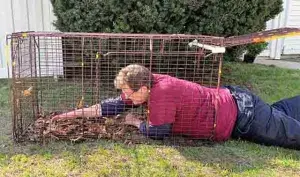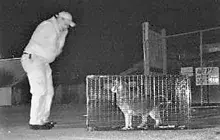
Finding lost dogs is Sheilah Graham’s passion, and her motto is Never Give Up.
For the past eight years, Graham, a TSA officer at Warwick, Rhode Island’s T.F. Green Airport (PVD), has volunteered her time and experience to assist families whose dogs have gone missing.
Graham has played a key role in reuniting over 250 dogs. One was lost for 764 days, and oddly enough was also the fastest one she was able to trap – in less than two minutes after the trap was prepped and positioned.
She believes it’s important not to chase dogs. Humane traps, trail cameras and high-valued food are Graham's go-to items.
"Some [rescues] end sooner, some later,” said Graham. “Depends on if a lost dog gets chased. An average search can last 11 to 21 days.”
Graham conducts presentations for local rescue groups, teaching them how to organize dog searches. She recently created a Facebook page – Lost Dog Trax Assistance – that can be used as a resource by anyone in the country. It provides recommendations and guidance if a dog is lost, helping families start their search process until they can get more experienced assistance.
Thousands of dogs are reported missing each year across the country, and many more go unreported. Some don’t end on a happy note. Some owners never find their lost pets.
“The last thing you want to do is have to go through the experience of losing a dog,” Graham said. “It is very stressful and can be a lengthy process.”
Graham offers these simple tips to prevent your dog from running away:
- Don’t leave your dog in your car or yard unattended.
- Avoid direct access to the outside, especially newly adopted pets.
- Don’t open doors in your home until your dog is secured, either by a leash or behind closed doors.
- Keep your dog on a leash and firmly hold the leash.
- Focus on your surroundings, not distractions.
If you’re driving a dog somewhere, Graham also suggests turning off your power windows. Paws can inadvertently roll down a window, allowing dogs to escape. Also, loop the dog’s leash through a locked seat belt to prevent the dog from bolting out of the car when you open the vehicle’s door.
If you lose your dog, Graham said you should “notify the chip company (if the dog has a chip), animal control, local police department and the rescue the pet was adopted from.”
“Post a simple flyer on social media,” she added, “and print flyers to distribute in your neighborhood. Make sure the people you speak with understand not to chase, approach or call out to your lost dog. You want people to know your dog is missing BEFORE they see [the canine] and not view it as a local dog on a stroll.”
Graham encourages us to share these tips. “By following these simple guidelines, we can prevent 90 to 95 percent lost dog cases," she said.
“Dogs can survive for days, weeks, months and years on their own regardless of size, age, medical conditions, terrain, weather, etc.,” said Graham. “Remember, they did fairly well on their own, long before they took over our sofas and stole our hearts.”
“Never give up!” she said. She doesn’t.


